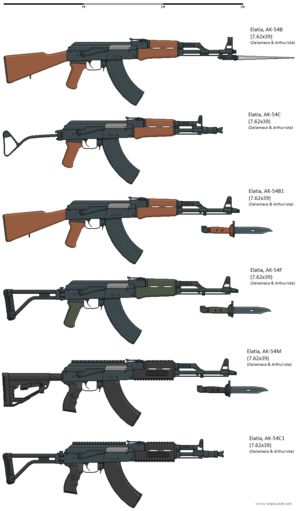AK-54
 AK-54 | |
| Place of origin | |
| Service history | |
| In service | 1955 - present |
| Used by | Elatian Army Charnean Army |
| Wars | Ninvite War |
| Production history | |
| Designed | 1953 |
| Produced | 1954 - present |
| Variants | See Variants |
| Specifications | |
| Weight | 3.6-3.8kg |
| Length | 882mm |
| Barrel length | 414mm |
| Cartridge | 7.62x39mm |
| Action | Gas operated, rotating bolt |
| Effective firing range | 400m |
| Feed system | 30-rounds box magazine |
| Sights | adjustable iron sight |
The AK-54 ('Automataa Karabinaay 1954') is a model of combat rifle employed by Elatia. Having entered service in 1955, it continues to be used as the Elatian Army's standard issue service rifle. It was adopted by the Charnean Army in 1981 to replace the Albarodan-63 assault rifle, and remains the standard issue Charnean service rifle to the present day.
Origin
Elatian infantry squads entered into the Belfro-Elatian War armed mainly with Olessun bolt-action rifles, 9mm submachine guns and magazine-fed light machine guns. As with many other armies during this period, they discovered that most firefights took place within 200m, and that the volume of suppressive firepower is often the decisive factor in winning engagements. Subsequent to the war, many younger officers advocated the wholesale introduction of assault rifles. This was resisted by the more conservative senior officers, who continued to see value in long-barreled infantry weapons. In 1948, it was decided that the K-48 semi-automatic carbine, chambered for the 7.62x39mm cartridge, would become the new service rifle of the Elatian military.
However, assault rifles were introduced into the Elatian Army through the back door, by being framed as a replacement for submachine guns. It was in this context that the later-ubiquitous design was copied. The Elatian infantry squad of the 1950's-60's consisted of ten people, with one light machine gun, one RPG, one submachine gun (carried by the RPG gunner), two AK-54 assault rifles, and six K-48 carbines, all carried in one halftrack copied from a Tsurushiman design. It was not until the 1970's that assault rifles finally completely supplanted the semi-automatic carbine as the main infantry weapon.
Variants
- AK-54: Original milled receiver variant with folding bayonet. Owing to the lesser industrial capability needed for its production (albeit greater need for skilled labour), milled receiver rifles were produced well until the 1990's alongside stamped versions.
- AK-54B: Stamped receiver version produced from 1965. The stamped receiver is slightly thicker and more robust than those commonly available. Produced with fixed, under-folding and wire-hanger stock types. Later batches (sometimes known as AK-54B1) feature updates such as slanted muzzle break, knife bayonet and non-enclosed front sight. The vast majority of rifles in Elatian service, even in regular units, remain wood-furnitured AK-54B or B1 models.
- AK-54C: Carbine variant with 314mm barrel.
- AK-54F: Has synthetic furniture and improved folding stock. Produced from 1995. They were first allocated to the Airborne Corps and Naval Infantry before slowly filtering out to other high readiness units.
- AK-54M: Has dust cover bracket, accessory rails and folding or fixed telescoping stock. Produced from 2015.
- AK-54MS: A rare variant of the AK-54M made by special forces gunsmiths. These guns are fashioned from old machined receivers for greater accuracy and durability at the expense of slightly greater weight.
- AK-54C1: The modernised version of the AK-54C, equipped with dust cover bracket and accessory rails.
AK-54S
The AK-54S Special Applications Carbine was introduced in the early-90's, primarily intended for use by special forces personnel in close assault missions. The carbine is chambered in the 9x39mm, a necked-up version of the standard service cartridge which combines the virtues of high stopping-power and armour piercing capability in a subsonic package for ease of integration with suppressors. These advantages come at the cost of the reduction of the weapon's effective range to within 200m. Because the rear sight is mounted directly onto the dust cover, the latter is secured into the receiver through the use of brackets located towards the rear of the weapon. The model was updated with accessory rails in the 2000's.
